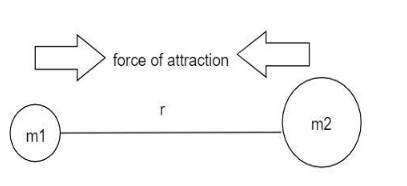
On the surface of the earth, force of gravitational attraction between two masses kept at distance $d$ apart is $6\,Newtons$. If these two masses are taken to the surface of the moon and kept at the same distance $d$, the force between them will be
(A) $1\,N$
(B) $36\,N$
(C) $\dfrac{1}{6}\,N$
(D) $6\,N$
Answer
565.8k+ views
Hint:Newton has given the law of the force of the attraction between the objects in the universe. Use this formula, substitute the given parameters and calculate the gravitational force of attraction on the moon and compare it with the earth.
Useful formula:
The law of gravitation is given by
$F = \dfrac{{G{m_1}{m_2}}}{{{r^2}}}$
Where $G$ is the gravitational constant, $F$ is the gravitational force between the object, ${m_1}$ is the mass of the first object, ${m_2}$ is the mass of the second object and $r$ is the distance between the objects.
Complete step by step solution:
It is given that the
Gravitational force between the objects, ${F_G} = 6\,N$

By the law of the gravitation, the force between the two objects in the universe is directly proportional to the product of their masses and inversely proportional to the square of the distance between them.
$F\alpha {m_1}{m_2}$
$F\alpha \dfrac{1}{{{r^2}}}$
By combining the above two equations, the law of the gravitation is obtained.
$F\alpha \dfrac{{{m_1}{m_2}}}{{{r^2}}}$
In order to avoid the proportionality sign, the gravitational constant is added. It is equal in all the areas of the universe like the moon, earth etc.
$F = \dfrac{{G{m_1}{m_2}}}{{{r^2}}}$
From the given data it is clear that the masses of the objects are also the same and also the distance between the objects are also the same on the surface of the moon similar to the earth surface. Hence the gravitational force between the objects in the moon is similar to that of the surface of the earth.
${F_m} = {F_G} = 6\,N$
Thus the option (D) is correct.
Note:The point to be remembered is that the gravitational force of the attraction between the objects is the same on the surface of the moon and the earth. But the acceleration due to gravity between the gravity surface like earth or moon and the objects varies. Since the acceleration due to gravity on the moon is $6$ times less than that of the earth.
Useful formula:
The law of gravitation is given by
$F = \dfrac{{G{m_1}{m_2}}}{{{r^2}}}$
Where $G$ is the gravitational constant, $F$ is the gravitational force between the object, ${m_1}$ is the mass of the first object, ${m_2}$ is the mass of the second object and $r$ is the distance between the objects.
Complete step by step solution:
It is given that the
Gravitational force between the objects, ${F_G} = 6\,N$

By the law of the gravitation, the force between the two objects in the universe is directly proportional to the product of their masses and inversely proportional to the square of the distance between them.
$F\alpha {m_1}{m_2}$
$F\alpha \dfrac{1}{{{r^2}}}$
By combining the above two equations, the law of the gravitation is obtained.
$F\alpha \dfrac{{{m_1}{m_2}}}{{{r^2}}}$
In order to avoid the proportionality sign, the gravitational constant is added. It is equal in all the areas of the universe like the moon, earth etc.
$F = \dfrac{{G{m_1}{m_2}}}{{{r^2}}}$
From the given data it is clear that the masses of the objects are also the same and also the distance between the objects are also the same on the surface of the moon similar to the earth surface. Hence the gravitational force between the objects in the moon is similar to that of the surface of the earth.
${F_m} = {F_G} = 6\,N$
Thus the option (D) is correct.
Note:The point to be remembered is that the gravitational force of the attraction between the objects is the same on the surface of the moon and the earth. But the acceleration due to gravity between the gravity surface like earth or moon and the objects varies. Since the acceleration due to gravity on the moon is $6$ times less than that of the earth.
Recently Updated Pages
Why are manures considered better than fertilizers class 11 biology CBSE

Find the coordinates of the midpoint of the line segment class 11 maths CBSE

Distinguish between static friction limiting friction class 11 physics CBSE

The Chairman of the constituent Assembly was A Jawaharlal class 11 social science CBSE

The first National Commission on Labour NCL submitted class 11 social science CBSE

Number of all subshell of n + l 7 is A 4 B 5 C 6 D class 11 chemistry CBSE

Trending doubts
Differentiate between an exothermic and an endothermic class 11 chemistry CBSE

10 examples of friction in our daily life

One Metric ton is equal to kg A 10000 B 1000 C 100 class 11 physics CBSE

Difference Between Prokaryotic Cells and Eukaryotic Cells

1 Quintal is equal to a 110 kg b 10 kg c 100kg d 1000 class 11 physics CBSE

State the laws of reflection of light




